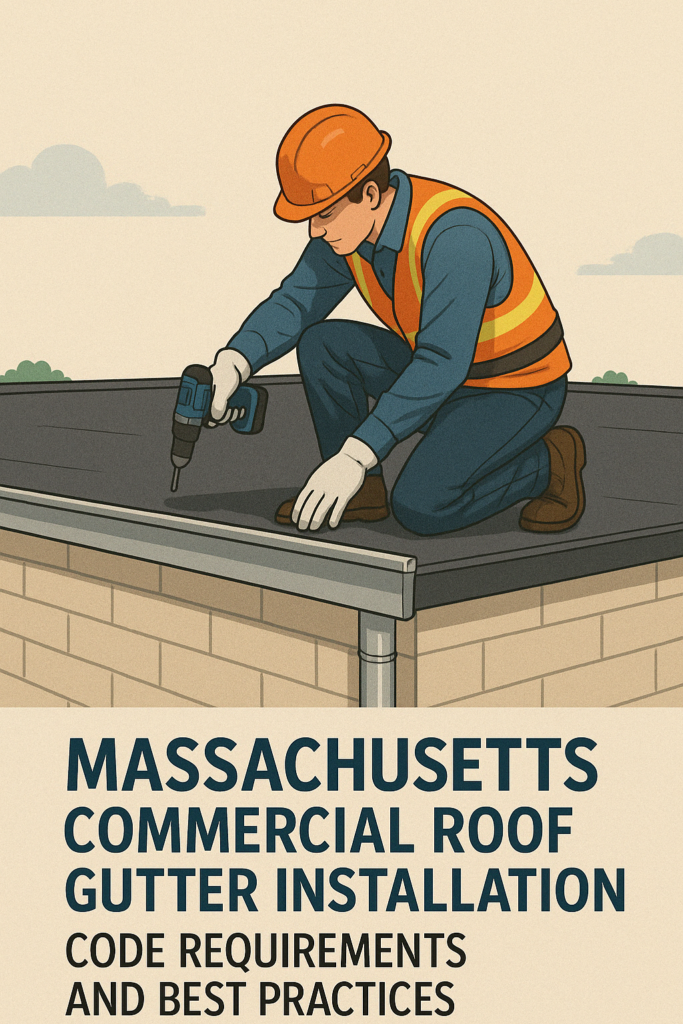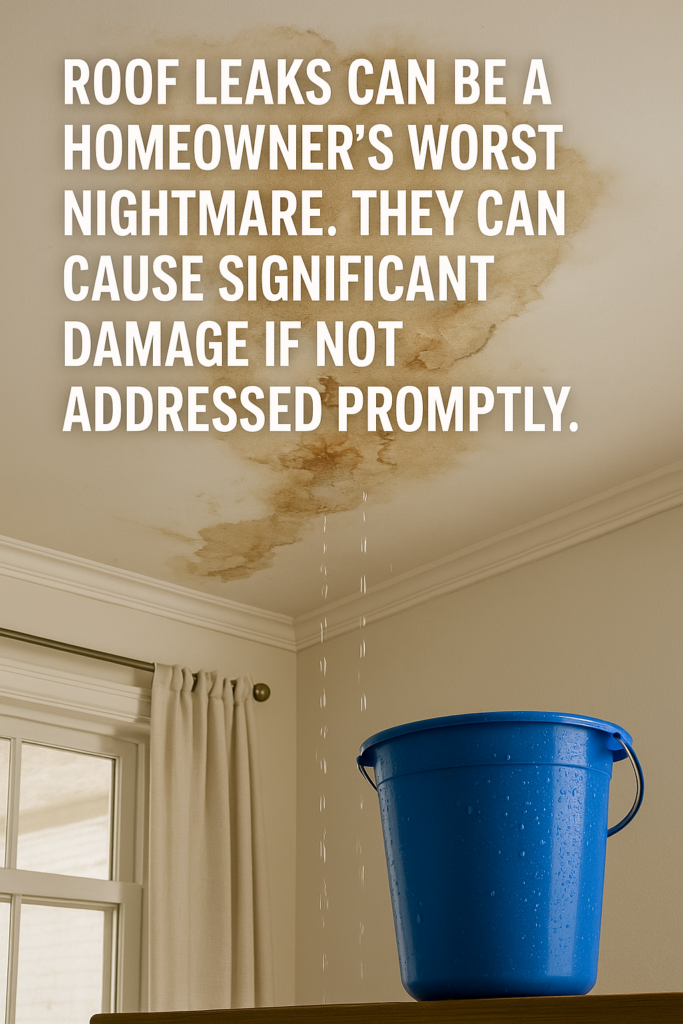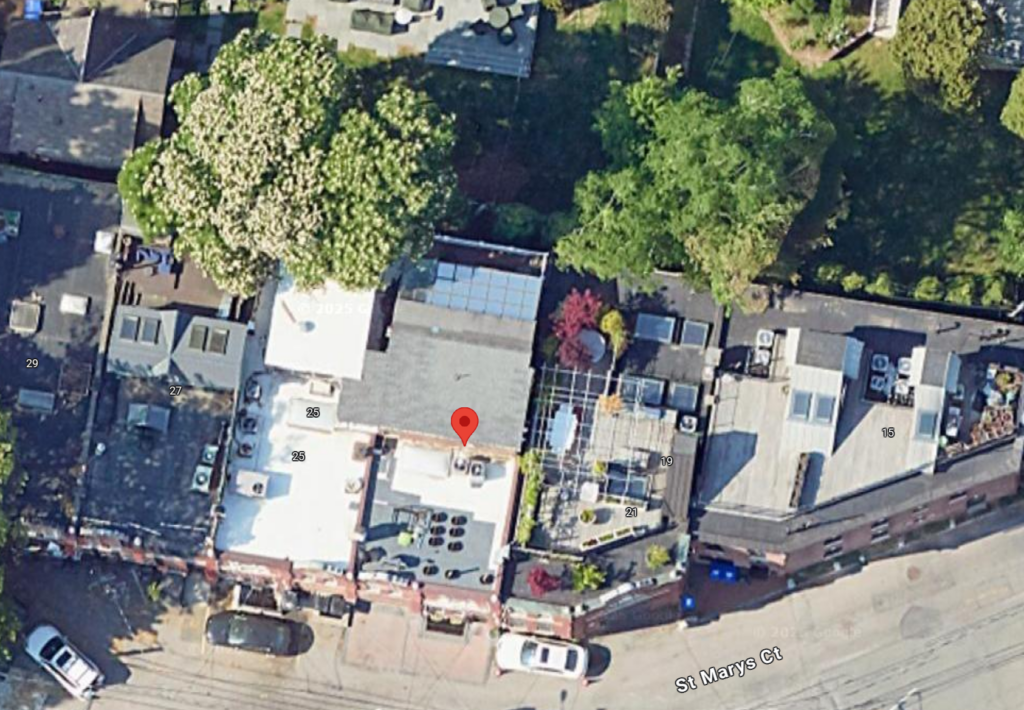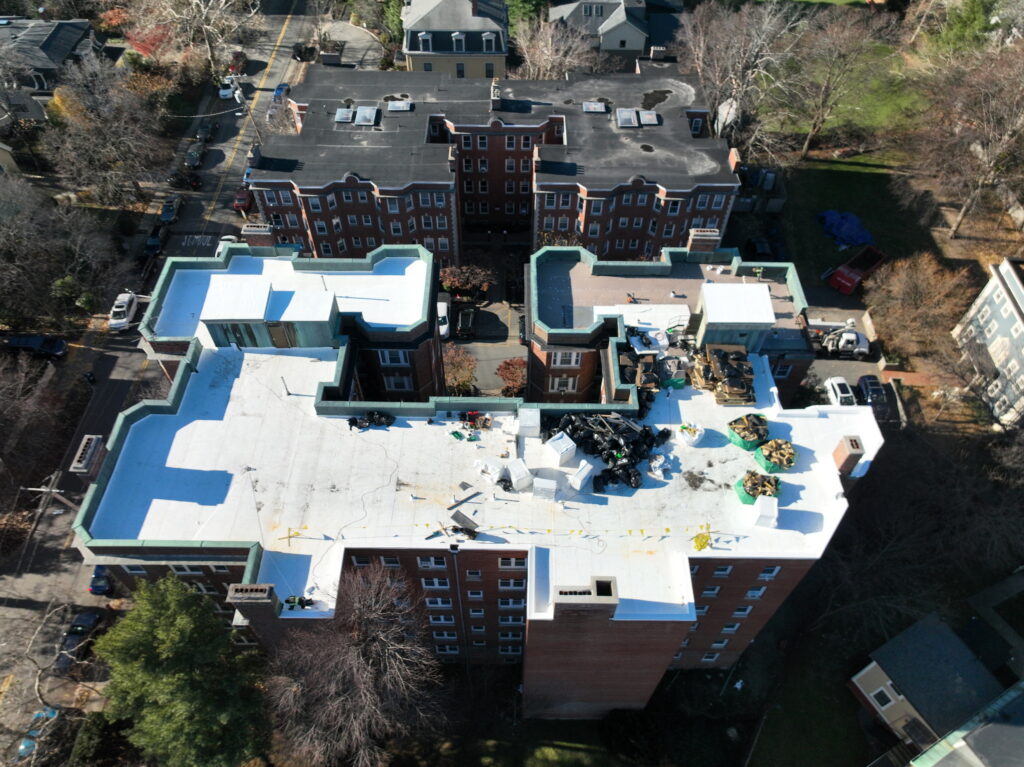Unlocking the Durability & Cost-Effectiveness of PVC Roof Systems
Reading Time: 9 minutesAs Dennis Tchernov, the leading roofer at ID Flat Roof, I’m here to explain why a PVC roofing system might be the perfect choice for your property. Known for its impressive durability and energy efficiency, PVC roofs have consistently proven reliable. In this guide, we’ll delve into everything you need to know about PVC roofing—from its straightforward installation process to cost considerations and how it compares to other materials on the market. I’ll ensure you have all the information to make an informed decision. Whether you’re looking to upgrade or install a new roof, understanding the benefits of PVC is the first step towards making a choice you’ll be confident in.
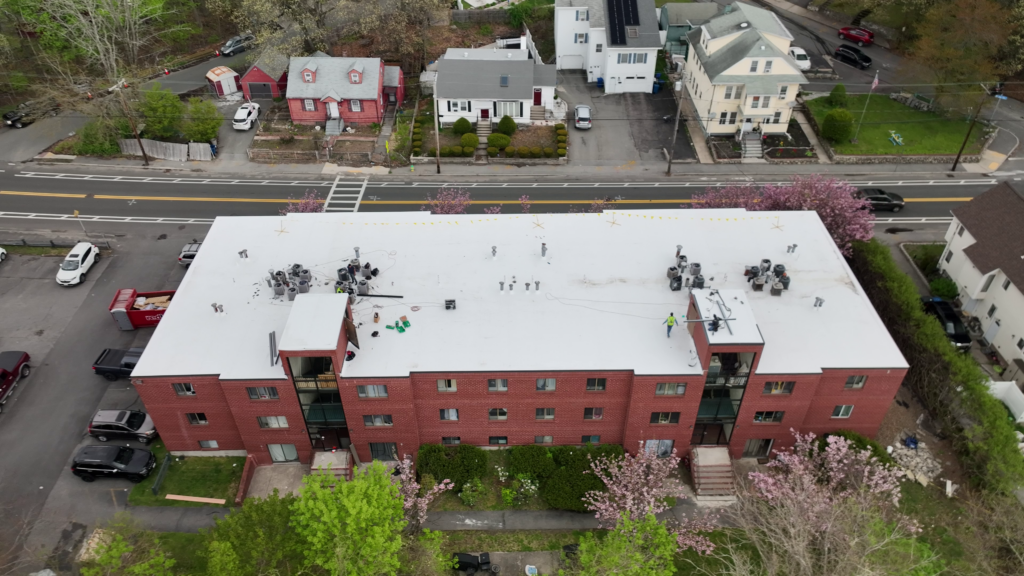
PVC Roof Takeaways
- PVC roofing is known for its durability, resistance to extreme weather and chemical exposure and energy efficiency. It offers a robust option for commercial, industrial, and institutional buildings.
- While PVC roofs boast a long lifespan of over two decades with minimal maintenance, they do come with higher initial costs and potential environmental concerns related to production and disposal.
- Proper installation by experienced professionals is critical for PVC roofing to ensure long-term performance and integrity, necessitating regular inspections and maintenance.
Understanding PVC Roof

Among various roofing systems, PVC roofing, a type of roofing material, distinguishes itself with its durability and cost-effectiveness. The system comprises polyvinyl chloride, a plastic material commonly used for flat and low-slope roofs. Since its introduction in the 1960s, PVC roofing has become popular for low-slope and flat-roof installations, particularly on commercial buildings.
PVC roofing membrane construction offers various products, including specialized PVC roofing solutions celebrated for cost-effectiveness and ability to meet diverse construction needs.
PVC roofing membranes can be customized according to durability needs and aesthetic preferences, with various colors, thicknesses, widths, and reinforcements.
Protect your home with Massachusetts’ top roofing experts. Visit our profile to see our work, and book your free consultation today!
What is a PVC Roof?
Fundamentally, PVC roofing is a synthetic plastic polymer employed in the roofing industry. Known for its strong, flexible, and highly resistant material properties, PVC roofing comprises two layers of PVC with a polyester reinforcement scrim sandwiched between them, UV-resistant additives on the top layer and plasticizers on the bottom. Since its market introduction in the 1960s, PVC roofing has become increasingly popular for its remarkable weatherability, flame-retardant characteristics, and ability to be blended with additives that further enhance its performance.
How PVC Roofing Works
The functionality and durability of PVC roofing systems derive from their heat-welded seams and reinforced layers. The seams in PVC roofing offer watertight bonds, which are crucial for maintaining the integrity of roofing systems, especially in institutional buildings. The insulation layer in these systems serves as a thermal barrier, helping to retain heating and cooling energy, which contributes to a building’s energy efficiency.
By reflecting UV rays and providing insulation, PVC roofing helps to minimize heat loss in winter and reduce air conditioning use in summer, leading to enhanced energy efficiency. Furthermore, the roofs can withstand high winds and deflect wind forces when properly installed, demonstrating their resistance to extreme weather conditions.
Advantages of PVC Roof

Why should one opt for PVC roofing? Besides its functionality and durability, PVC roofing systems are recognized for their versatility across various building types, notably commercial, industrial, and institutional buildings. These roofs are known for their impressive resilience to severe weather, making them a robust option for protecting buildings.
Furthermore, the cost-effectiveness of PVC roofing can be attributed to its endurance, which reduces the need for frequent replacements and contributes to low maintenance requirements over its lifespan.
Durability and Longevity of PVC Roof
An impressive breaking strength is a crucial advantage of PVC roofs, exceeding the American Society of Testing and Materials’ standard of at least 350 pounds per inch squared. This durability is demonstrated time and time again, considering PVC roofing’s reliable performance against fire, chemicals, and extreme weather conditions since its adoption over 35 years ago in commercial settings.
Whether installed in industrial environments, institutional structures, or residential homes, PVC roofing systems boast a longevity that can exceed two decades, often reaching up to 30 years or surpassing it with proper maintenance.
PVC Roof Energy Efficiency
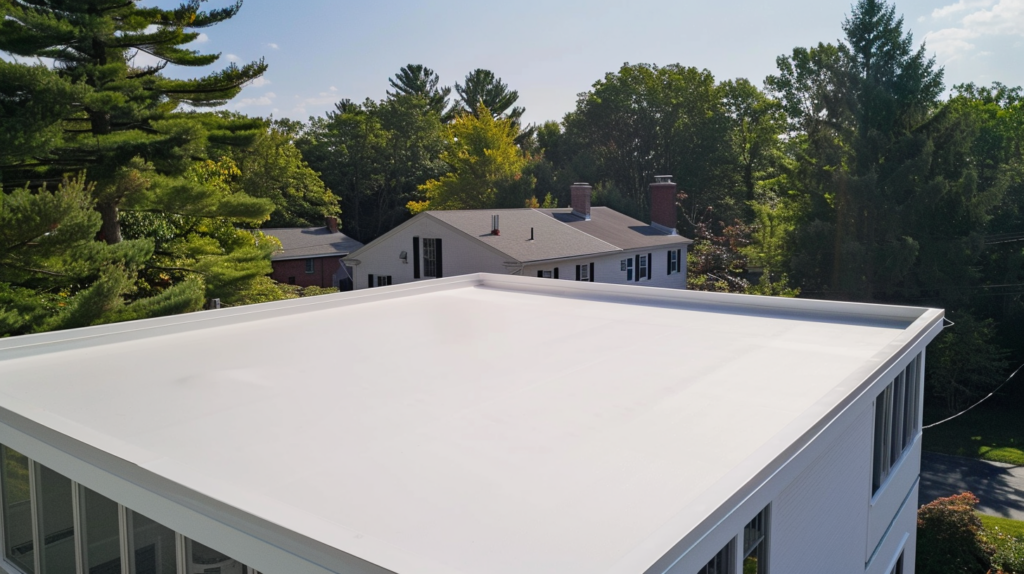
Beyond durability, PVC roofing systems also exhibit energy efficiency. They help reduce energy costs by reflecting UV rays and maintaining interior coolness. The reflective properties of PVC roofing materials contribute to lowering energy consumption by reducing interior temperatures. Especially in climates that experience high levels of sunlight, PVC roofing’s solar reflectivity assists in regulating building temperatures and reducing energy consumption.
This energy-saving capability is favored in industrial facilities, helping to keep interiors cool and reducing reliance on air conditioning. Even institutional buildings such as schools and hospitals gain additional energy efficiency from PVC roofing’s ability to block harmful UV rays, contributing to lower energy requirements during peak sunlight hours.
Low Maintenance Requirements
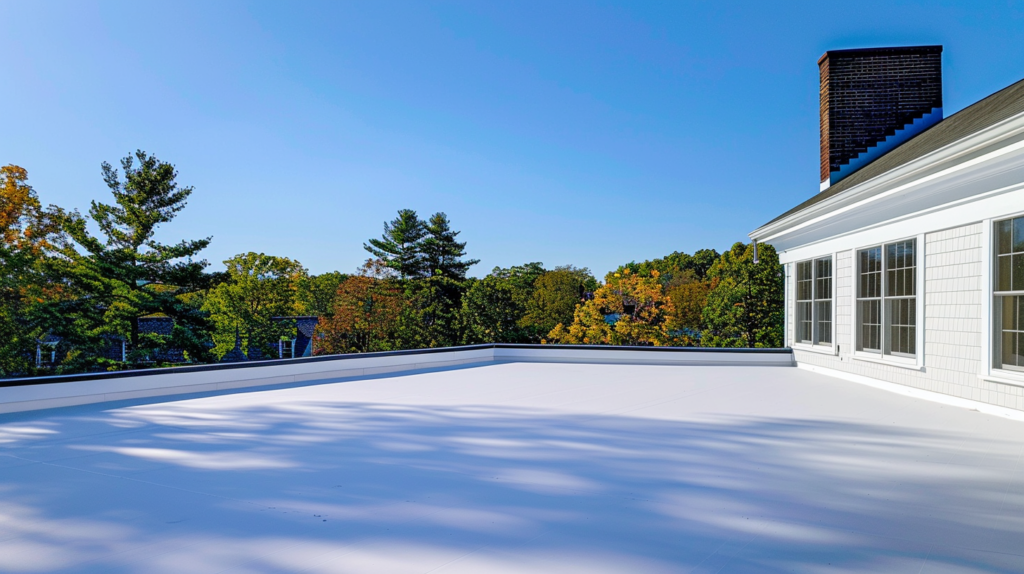
Another advantage is that PVC roofs necessitate minimal maintenance, contributing to their cost-effectiveness and practicality for building owners. The maintenance routine for PVC roofs typically involves only periodic inspections and cleaning to ensure optimal performance.
Moreover, PVC roofing systems offer easy repairs and maintenance access, which is particularly valued in institutional buildings.
Resistance to Chemicals and Weather
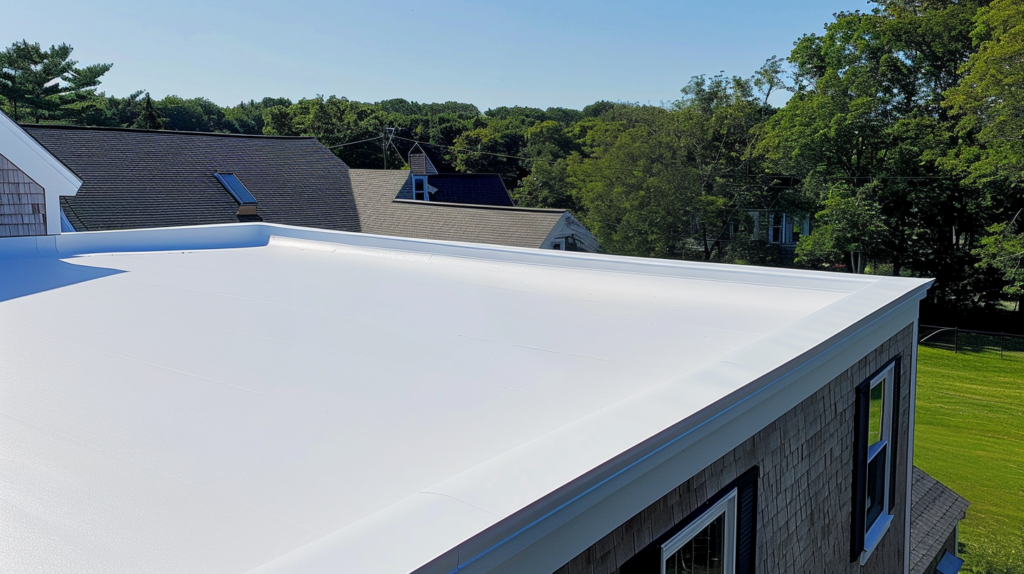
PVC roofs are notable for their resistance to harmful elements, including chemicals, UV rays, and different weather conditions, contributing to their overall longevity and performance. Due to its advanced material composition, PVC roofing exhibits superior chemical resistance and remains non-reactive to numerous substances, distinguishing it from other materials, such as TPO membranes.
Engineered to endure harsh weather conditions, PVC roofing maintains its integrity and resiliency in the face of extreme elements like snow, hail, rain, and high winds, enhancing the roofing system’s durability. Especially in industrial and commercial environments, such as restaurants and airports, PVC roofing proves beneficial due to its high resistance to conditions like grease, fire, and exposure to aggressive chemicals.
Potential Drawbacks of PVC Roofing Systems
Despite offering numerous advantages, PVC roofing systems also come with potential drawbacks worth considering. These systems often entail higher initial investment costs than other roofing materials, which can be a significant drawback for some building owners or developers. In addition, the production and disposal of PVC roofing materials raise environmental concerns due to potential chemical releases and challenges with recycling.
Furthermore, proper installation is critical for PVC roofing systems, as improper installation can lead to temperature sensitivity and seam failures.
Initial Investment Costs
Compared to other roofing materials, the upfront cost for a PVC roofing system can be higher, such as EPDM, which is known to be more affordable. The typical cost for PVC roofing systems ranges from $5.50 to $9.50 per square foot, representing a considerable initial investment. Specialized equipment needed for installing PVC roofing adds to the overall initial costs of the roofing system.
However, investing in a PVC roofing system shifts the distribution of expenses towards the materials themselves, as opposed to labor, in the initial installation phase.
Environmental Impact
Environmental concerns arise from producing PVC roofing, which uses fossil fuels and generates byproducts that pose ecological issues. The PVC roofing industry has been scrutinized for emitting toxic chemicals such as dioxins; however, research suggests that the industry’s contribution to these emissions is minimal. Substances used in PVC roofing, like phthalates, are not persistent, do not accumulate in organisms, and are not easily biologically assimilated due to their low solubility in water.
On a positive note, PVC roofing materials can be recycled, aiding sustainability efforts and appealing to environmental consciousness.
Installation Considerations
For PVC roofing installation, the substrate must be adequately prepared, including repairs to the roof surface, like sealing cracks, to ensure a solid foundation for the roofing membrane. Properly sealed seams are essential to preventing leaks, with particular attention needed for T-joints where three sheets meet, as these are common points of vulnerability.
When covering old or damaged roofs, it is recommended to:
- Use a slip-sheet or fleece backing to create a uniform surface for the PVC membrane installation
- Account for temperature fluctuations during installation, as PVC roofing materials can expand or contract in response to extreme temperature changes, which can lead to shrinkage
- Hire experienced roofers adept at mitigating leaks, seam failures, and premature aging through skilled craftsmanship.
Moreover, PVC membrane repairs or modifications require proficiency with techniques such as hot air welding to maintain the roof’s integrity over time.
Explore Our Boston Flat Roof Project
Roof Replacement Project at 13 Stanhope St., Boston
Comparing PVC Roof to TPO Roof
How does PVC roofing compare to other popular roofing systems like TPO? PVC and TPO are the two most common white commercial roofing membranes, with TPO systems typically being lower in cost than PVC roof membranes. TPO and PVC roofing systems can be mechanically fastened or fully adhered to, but TPO uniquely requires the installation crew to craft most flashing details on site.
Ultimately, PVC and TPO roofing systems differ in their materials and performance factors, influencing their suitability for various applications.
Key Differences
While both PVC and TPO roofing systems meet crucial safety standards for fire resistance set by Factory Mutual and Underwriters Laboratories, there are a few key differences to note. For one, TPO roofing membranes are quantifiably more durable regarding tear and break strength than PVC, with a higher tear strength at 55 lbf over PVC’s 45 lbf.
Choosing the Right System
Choosing the appropriate commercial roofing system is a long-term investment that requires careful evaluation of building-specific factors. It would be best to consider seeking professional guidance to ensure you’re making the most informed decision.
PVC Roof Applications
PVC roofing is suitable for a variety of building types, including:
- Commercial buildings
- Industrial facilities
- Institutional buildings
- Residential homes
At the end of their service life, PVC roofs can be entirely recycled into new roofing materials, reducing waste and underscoring the system’s sustainability.
Commercial Buildings
Commercial buildings, particularly those with low-slope or flat roofs, commonly prefer PVC roofing for its cost-effective installation and durability. PVC roofing systems are versatile and have different installation options, such as mechanically attached, fully adhered, and non-penetrating fastening systems suitable for various commercial building needs.
A ballasted PVC roofing system is less common today and is typically used for commercial buildings. In this system, the membrane is pressed down with ballast-like gravel.
Industrial Facilities
PVC roofing is valued in industrial settings for its chemical resistance, energy efficiency, and low maintenance requirements. PVC membranes can withstand long-term exposure to various industrial emissions without degradation. The low maintenance requirements of PVC roofing align well with the needs of industrial facilities, reducing downtime and maintenance costs.
In addition, due to their high reflectivity, PVC roofs can decrease cooling requirements, thus saving energy in industrial buildings.
Institutional Buildings
For institutional buildings, PVC roofing systems offer several benefits:
- Durability and flexibility, which are essential for complex roof designs
- Longer lifespan, reducing the need for frequent replacements
- Cost-effectiveness, making it a long-term roofing solution for institutional buildings
PVC roofs require minimal maintenance, a key feature for institutions with limited operational budgets for ongoing facility management. Furthermore, schools and hospitals require roofing materials that align with strict health and safety regulations, and PVC roofing systems support those compliance needs.
Residential Homes
PVC roofing is a versatile option for residential homes. It provides a range of colors, thicknesses, and reinforcements that can be tailored to complement different architectural styles and homeowner preferences. PVC roofing is particularly suitable for homes with flat or low-slope roofs, offering a long lifespan, excellent wind and leak protection, low maintenance requirements, and enhanced energy efficiency.
Installation Tips and Best Practices
Following specific key installation tips and best practices is essential to maximize the benefits of a PVC roofing system. Choosing a qualified installer for PVC roofing is crucial to ensure the roof is installed correctly and to facilitate regular inspections.
After installation, consistent inspections and maintenance are vital for optimizing the system’s performance and extending the longevity of the PVC roof.
Choosing a Qualified Installer
Hiring experienced professionals is crucial when installing PVC roofing to ensure proper application and optimize the roofing system’s performance. A skilled installer can reduce labor costs by efficiently working with fleece-backed PVC membrane roofing, which provides additional support and is easier to install.
The longevity and overall durability of a PVC roof can be significantly affected by the quality of the installation process, underscoring the need for qualified professionals.
All You Need to Know About PVC Roofing
Regular Inspections and Maintenance
Routine maintenance for PVC roofing includes inspections and cleaning debris to ensure a long service life. Due to simple access and the availability of easy-to-apply repair materials, PVC roof repairs can be swiftly and easily conducted when needed.
To avoid leaks, a proper drainage system is essential for a PVC roof system to prevent water from accumulating.
Summary
In conclusion, PVC roofing offers numerous benefits, such as durability, energy efficiency, low maintenance, and resistance to chemicals and weather, making it a robust option for various building types. While its higher initial investment cost and environmental considerations are essential, the system’s longevity and overall performance make it worthwhile. With proper installation and regular maintenance, a PVC roofing system can provide reliable protection for your building for decades.
Frequently Asked Questions
PVC roofing is a synthetic plastic polymer known for its strong, flexible, and highly resistant material properties. It is commonly used in the roofing industry.
PVC roofing offers durability, energy efficiency, low maintenance, and resistance to chemicals and weather, making it a reliable choice for various roofing needs.
The potential drawbacks of PVC roofing include higher initial investment costs, environmental concerns related to production and disposal, and the need for proper installation. Be mindful of these aspects when considering PVC roofing for your property.
PVC roofs offer better chemical resistance and weatherability than TPO roofs, while TPO systems are generally more cost-effective.
Conduct routine inspections and clean debris regularly to ensure a long service life for your PVC roof.
Denis is the driving force behind ID Flat Roof, a leading company in Boston specializing in flat roof repair and installation for over 20 years.
Expertise:
Denis excels in PVC, TPO, EPDM, and rubber roofing. His meticulous approach ensures quality and customer satisfaction.
Innovation:
Denis incorporates cutting-edge solutions like skylights and solar PV roofing.





